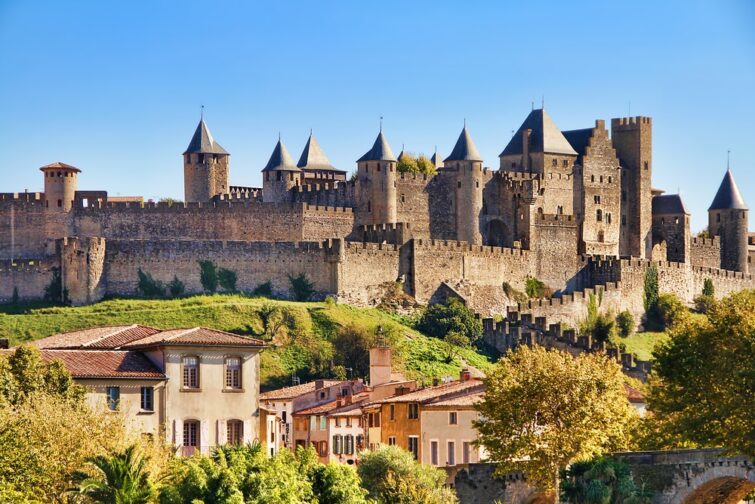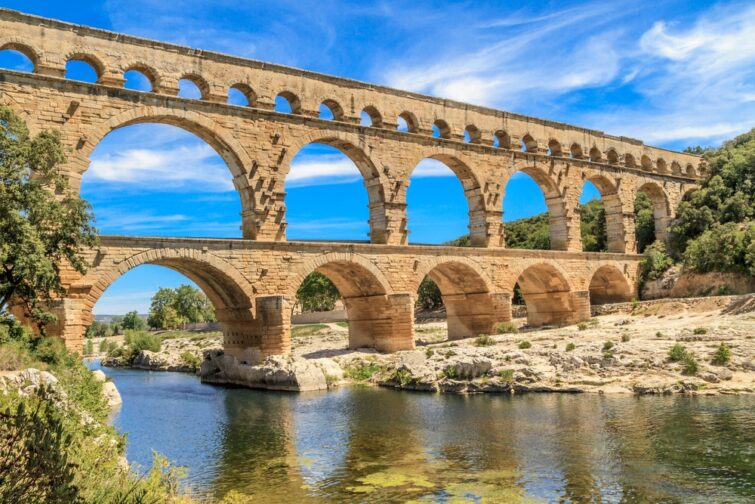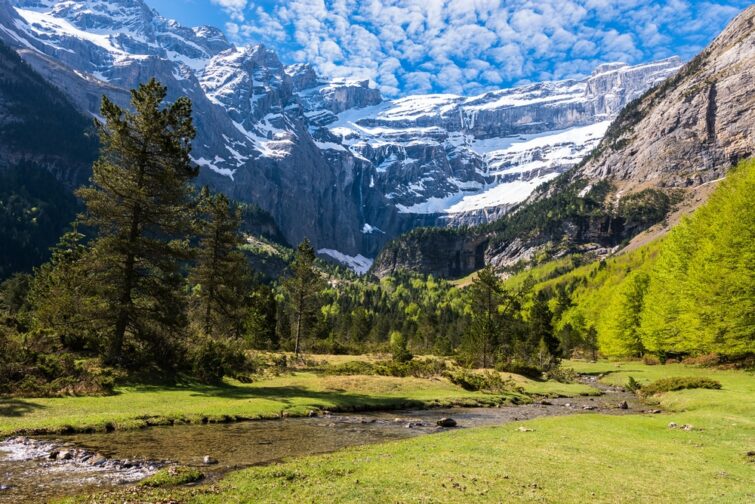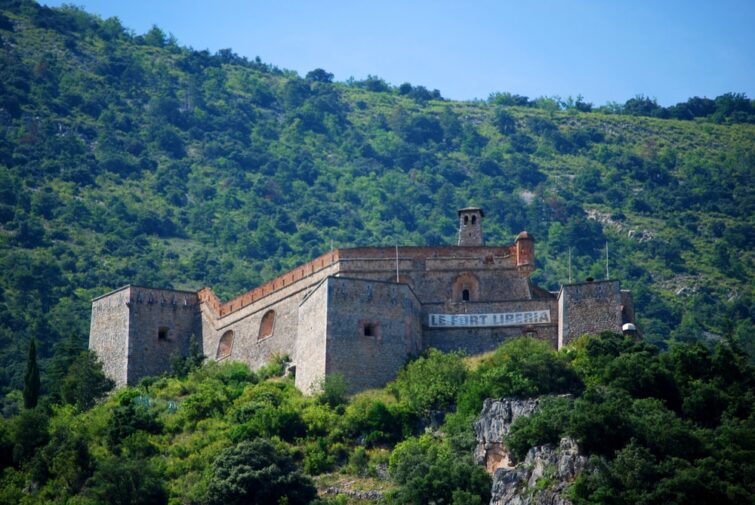The South of France is full of treasures recognized as exceptional for the common heritage of humanity. The proof with these 8 UNESCO World Heritage sites to discover in Occitania
Summary
- 1. The episcopal city of Albi
- 2. The city of Carcassonne
- 3. The Canal du Midi
- 4. The Pont du Gard
- 5. The Gavarnie circus
- 6. The Causses and the Cevennes
- 7. The Vauban fortifications
The Occitanie region unites the former regions of Languedoc-Roussillon and Midi-Pyrénées. It is shared by Toulouse and Montpellier , licked by the Mediterranean Sea, pierced by the mountains of 7 the Pyrenees , crippled by perched villages and vibrant with traditions. Here is an overview of the UNESCO World Heritage sites to discover in Occitania.
1. The episcopal city of Albi

Photo credit: Shutterstock – Nata Shilo com
Since 2010, Albi has been enthroned among the high places of the Cultural Heritage of Humanity and has one of the most beautiful Unesco sites in Occitania. It must be said that its cultural and architectural heritage has something to impress and arouse general interest. This former capital of the pastel trade retains marvelous mansions and breathtaking religious ensembles. The city of Albi is particularly photogenic with its characteristic red bricks. Moreover, its brick cathedral, Sainte Cécile, is the largest built in this flamboyant material.
Whether you choose to visit Albi on your own or on a guided tour, the city has plenty to keep you busy for a day or two. Among the essentials of Albi are the Albigensian mills, the banks, the cathedral and its old bridge, the covered market, the hotels (Reynès and Gorsse), the houses (Enjalbert and old Alby), the medieval districts or the palace adjoining the famous Toulouse-Lautrec museum.
This quick tour allows you to grasp the culture around the wheat and the mills, enjoy the beautiful views of the Episcopal City and span the Tarn from one bank to the other. You then dive into a unique feudal setting before strolling through the aisles of a market where local products are piling up.
Eventually, you discover the superb mansions and their exquisite courtyards. Not far away, the half-timbered houses of wood and brick of Old Albi transform the urban landscape. The palace, meanwhile, immerses you in another dimension with its immense vaults, its medieval floors, its painted ceilings, its Renaissance gallery and its remarkable garden.
2. The city of Carcassonne

Photo credit: Shutterstock – Rolf E. Staerk
The city of Carcassonne and its fortifications are several hundred years old. It has gone through many trials, been destroyed and rebuilt many times over the years. This is also what gives the City a unique architectural combination. One of the most famous Unesco sites in Occitania, Carcassonne has been a World Heritage Site since 1997 and continues to attract visitors from all over the world.
You usually enter through the Porte d’Aude. Immediately, you come across the beautiful facades of the half-timbered houses and the squares overflowing with charm. History unfolds before your eyes through its famous monuments such as the Saint-Nazaire basilica and its superb gargoyles, the castle towers and of course the unmissable ramparts. From this defensive stone belt, the views are breathtaking over the old town, the black mountain and even the Pyrenees.
In order to visit the City of Carcassonne , several routes are possible, paying or not. In any case, don’t miss the count’s castle, the walkways and the long strolls in the maze of pink alleys. We also advise you to taste the unique atmosphere of Carcassonne at nightfall, when it is adorned with magical sounds and lights.
3. The Canal du Midi

Photo credit: Shutterstock – PAUL ATKINSON
The Canal du Midi meanders from Toulouse to Sète . This historic river route takes you through changing and bewitching scenery. You discover in turn the green hills, the sunny vineyards and the picturesque villages. The Canal du Midi is one of the oldest Unesco sites in Occitania.
It flows over two hundred and forty kilometers and crosses no less than three departments. Moreover, on the way, you will come across the medieval city of Carcassonne. Other major points of interest along the canal: the Ville Rose – Toulouse – and its barges, the basin of Castelnaudary, the locks of Fonserannes, the birthplace villages of cassoulet and the port city of Sète.
This river path is divided into several stages and offers à la carte stays. You can travel along the Canal du Midi by barge, bicycle or on foot. On the waters, the crossing is absolutely peaceful and timeless, offering unforgettable encounters with the lock keepers. By bicycle, you can follow the perfectly landscaped greenways along the canal and are generally shaded. Most hotels on the waterfront welcome cyclists and offer a rental service and/or transport of luggage from point A to point B.
Finally, if you want to walk in the shade of the plane trees along the Canal de Midi, you will have plenty of time to immerse yourself in the places encountered and walk a long way with many pilgrims keeping you company. The terrain is flat and well maintained but we advise you to define the section you want to cover over a few days.
4. The Pont du Gard

Photo credit: Shutterstock – Bertl123
Our classification of Unesco sites in Occitania brings us close to Nîmes , Capital of ferias, jeans and arenas. The Pont du Gard , thirty minutes from the city, is a magnificent two-thousand-year-old Roman aqueduct. This architectural masterpiece is one of the most precious ancient remains in the world.
The site has two banks respectively named right bank and left bank. Access to the Roman site is paying and offers many activities. In particular, it spans Le Gardon, a pretty river where it is good to swim or go canoeing. Its banks are fantastic for a picnic with the huge arches of the monument as a backdrop.
Around the Pont du Gard, you can also hike on very accessible paths, piercing the Garrigue and criss-crossing to small villages. In summer, many events take place on the Roman site, including musical nocturnes and a sound and light show that are absolutely worth the detour. On site you will also find a museum and a restaurant promoting local products.
5. The Gavarnie circus

Photo credit: Shutterstock – Sake van Pelt
The entire Pyrenees National Park is part of the Unesco sites in Occitania. It must be said that her beauty is as virulent as it is obvious. Within the park, crowned with snow-capped peaks, you will find in particular the glacial cirque of Gavarnie .
This dizzying amphitheater is the most famous natural arena in France. The place is striking. On the steep slopes of this basin, waterfalls break and birds of prey make their nests. Twenty thousand years ago, a glacier stood here and carved out the steep-sided valley that unfolds before your eyes. Many hikers come to rub shoulders with the open paths on the 1,500-metre high walls, on the waterfalls falling over more than 400 meters for the largest and on the Breche glaciaire de Roland.
This site of exceptional beauty is very accessible on foot, on horseback or by donkey. The main hike takes just three hours. To explore the place away from the crowds, you can quite take other paths, more or less muscular, traced around the stone arch.
6. The Causses and the Cevennes

Photo credit: Shutterstock – Rudmer Zwerver
The Causses and the Cévennes , wild, spectacular and rich in their traditions, constitute a unique natural landscape in France. They hold on to the least populated department of the country, Lozère , and two other departments, Gard and Hérault . The entry into the Unesco Heritage of the Causses and the Cévennes dates from 2011.
The causses bring together many megalithic sites to visit during real walks in the land of menhirs. The capital of the Cévennes, Florac, is well worth a stop. This pretty village pierced by waterways sparkles at the foot of the Causse Méjean. Close to Florac is the charming village of Quézac, located at the entrance to the Gorges du Tarn. Yes, it is indeed the natural place from which spring the sparkling waters prized in France.
The Causses overlook the Gorges du Tarn : a bewildering landscape emblematic of Lozère. They extend between the towns of Ispagnac and Le Rozier, criss-crossing incredible small Cévennes villages and can be explored on foot or by canoe-kayak. Along the way, don’t miss the adorable cobblestone medieval village of Sainte-Enimie or that of Saint-Chély-du-Tarn, which bathes in the green waters of the Tarn.
The Causses and the Cévennes, their vast desert and hilly steppes and their karstic rocks, contain other treasures. Namely the mythical caves of Aven Armand and Dargilan. These two underground gems offer a real journey to the center of the Earth and an incredible discovery of the world dug under our feet.
7. The Vauban fortifications

Photo credit: Shutterstock – James Wagstaff
The works of Vauban , twelve in number in France, were born thanks to the genius of this military architect. Its fortifications are as many citadels, urban enclosures with bastions and bastioned towers classified as UNESCO sites in Occitania. They have become fundamental in the history of Western military architecture and today constitute an outstanding universal value. They testify to the strategic theories of the 17th century, used until the middle of the 19th century. Two of Vauban’s creations are present in Occitania.
First set out to conquer the fortified city of Villefranche-de-Conflent and its Fort Liberia . The town nestles near Perpignan , in the preserved environment of the Pyrénées-Orientales . It is built in pink marble and adapts remarkably well to the natural topography of the place.
Villefranche-de-Conflent is dominated by Fort Liberia, which opens onto an exceptional panorama of the Canigou. This Vauban fortress protected the village and served as a prison. You will discover the longest underground passage in the world: seven hundred and thirty-four steps that connect Fort Liberia to its village. This flight can be climbed and descended on foot for the bravest or by shuttle.
Still in Occitania, head towards the highest fortress in France: Mont-Louis . It was built by Vauban to seal the passage of the Pyrenees. Its square shape flanked by bastions and ramparts is beautifully preserved.
Villefranche-de-Conflent and Mont-Louis are served by the famous Yellow Train, emblem of the Catalan country.
8. The roads of Santiago de Compostela

Photo credit: Shutterstock – Franck-A
We ended this top Unesco sites in Occitania with the paths of Saint-Jacques-de-Compostelle , a major place of Christian pilgrimage. This historical itinerary often resembles an initiatory journey. The Spanish portions of the path, sixty-nine monuments spread over the French paths and seven portions of the Puy-En-Velay path are listed as World Heritage by Unesco. The origins of the Ways of Saint James date back to the year 800. They take their name from Saint James the Greater, one of the first apostles of Christ.
Rare are those who set off on the entire route (more than forty days of walking). However, it is divided into several routes shared between France and Spain , to be taken according to your desires and possibilities.
The French Voie du Puy attracts visitors for its natural landscapes and the architectural treasures that mark it out. This is the busiest portion, therefore the most conducive to accommodation and meetings.
The Arles Way connects the eponymous French town and the Puente la Reina in Spain. It extends over eight hundred kilometers of very varied landscapes in terms of relief, fauna, flora and altitude.
The Vézelay route crosses the Limousin countryside, the Loire, between the two seas and the immense Landes forest to arrive at Saint-Palais. There is also a variant by Bergerac, in the heart of the Bordeaux vineyards.
The Tours route is the oldest and richest route from an architectural point of view. It also runs along the greenways from Orléans to Tours for cycling enthusiasts.
The Stevenson path connects Le Puy-en-Velay and Arles, crosses sumptuous territories including the rebel Cévennes mentioned above.
Did you like this article? Do not hesitate to share it on social networks and subscribe to Discover the World on Google News to not miss any articles!